Book reviews
 |
 |
 |
 |
 |
 |
 |
How Vietnam Catholic President Diem
Was Betrayed by America
Book review of The Lost Mandate of Heaven – The American Betrayal of
Vietnamese President Ngo Dinh Diem by Geoffrey Shaw,
San Francisco: Ignatius Press, 2015, 313 pp.
Vietnamese President Ngo Dinh Diem by Geoffrey Shaw,
San Francisco: Ignatius Press, 2015, 313 pp.
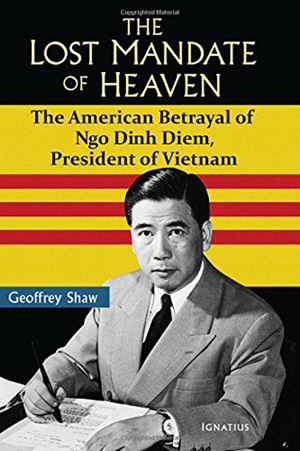
The book is authored by Geoffrey Shaw past Assistant Professor of History at the American Military University and present president of the Alexandrian Defense Group, which is devoted to the study of counter-insurgency warfare.
In the very interesting Foreword to the book, Fr. James V. Schall, S.J., points out that Diem had been to early morning Mass the day of his assassination, which seemed to him to be more a martyrdom than a political murder. His assassination had been set up by President John F. Kennedy, high-ranking members of the State Department, Sen. Mike Mansfield and much of the press, especially The New York Times, this book recounts.
Quoting the Socratic principle that it is never right to do wrong, Fr. Schall emphasizes that the final defeat in Vietnam was not really on the battle ground but on the political and moral terrains or, even worse, on the personal grounds of high-handed diplomats and reporters.
The loss of South Vietnam to the communists was a consequence of moral and intellectual deficiencies on the part of American advisors. “The killing of Ngo Dinh Diem was not the death of a corrupt politician. It was a step in the death of the basic principle on which civilization rests,” he notes. (p. 15)
Here is a line-up of the main characters, both good and evil:
- Ngo Dinh Diem, a high ranking mandarin of the Nguyễn dynasty and leader of the Catholic element that named him President of the first Republic of Vietnam in 1955;
- Ngo Dinh Nhu, his brother;
- Frederick Nolting, American Ambassador to South Vietnam (1961-1963);
- William Colby, CIA Chief of Station in South Vietnam (1959-1962);
- Sir Robert Thompson, a British counter-insurgency expert;
- W. Averell Harriman, U.S. State Department member in charge of Southeast Asia.
Diem was born in the north of Vietnam to a distinguished family. His father was a court minister and a chamberlain to the Emperor at the court in Hue. He was educated in a French Catholic school and later in the National College, graduating at the top of his class in Law and Administration in 1921 in Hanoi.
Diem, a devout Catholic who at one time considered the priesthood, was a true conservative who was oblivious to fortune-hunting in office. While President of the Republic of South Vietnam, he slept on a cot in the National Palace and attended daily Mass. Traditional Vietnamese society was structured with men of letters or scholars at the top, followed by the peasant farmers, the workers, the merchants, and last, the soldier military class.
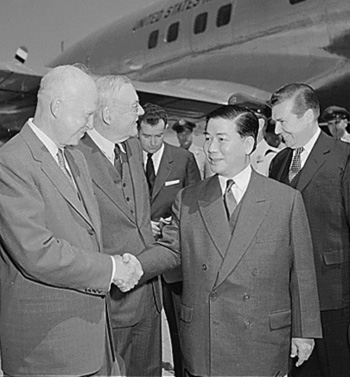
Diem is greeted by President Eisenhower and Secretary of State Dulles on his 1967 visit to the U.S.
In 1950, Diem visited Rome and met Pope Pius XII. Afterwards, he spent two years living in Maryknoll seminaries in the U.S. where he met Cardinal Spellman, Supreme Court Justice William O. Douglas, Sen. Mike Mansfield and Congressman John F. Kennedy. In 1953 he spent some time in a Belgian Benedictine Monastery and joined the Third Order of the Benedictines committed to living by the Rule of St. Benedict.
After the defeat of the French by the communist Viet Minh in 1954 at the Battle of Dien Bien Phu, Vietnam was partitioned by the Geneva Convention. The Communist Democratic Republic of Vietnam controlled the north, and Diem was named Prime Minister of the south. In 1955, he was elected President of South Vietnam and continued his struggle for a free, non-communist government and country.
As President he had good advisors including Sir Robert Thompson, a British counter-insurgency expert who had been involved in the defeat of the communists in Malaysia. The tactic Thompson successfully employed there was to develop a grass roots structure with the people and build a local militia instead of relying on a large army.
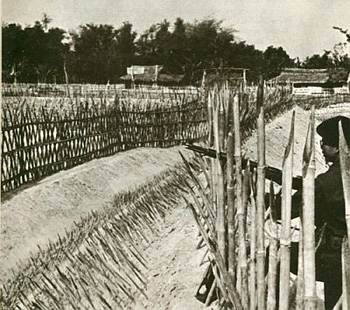
A typical self-contained hamlet protected by bamboo fences and local police
In 1962, crucially situated Laos was declared neutral at an International Congress in Geneva. The West duly observed the neutrality and removed their military forces. However, as Dr. Shaw points out, the communist forces, about 50,000 strong, remained. This gave rise to the infamous Ho Chi Minh Trail, giving the Viet Cong, the communist-led army and guerrilla forces, ready access from North to South Vietnam for supply and strategic purposes.
Much later, in a talk with good friend Charles Bartlett, John Kennedy revealed that he recognized that the Laotian neutrality deal, which he and Harriman supported, had handed the country over to the communists. (p. 247)
A biased press and the Buddhist crisis
Another factor crucial to the loss of South Vietnam was the bias of the press. The journalists’ negative reporting of the anti-communist Vietnam War soured public opinion in the US. In the early '60s, young American journalist David Halberstam of the New York Times and Neil Sheehan of United Press International made names for themselves by falsely reporting that the war was being lost due to Diem’s corrupt government. They called his Strategic Hamlet Project a sham when in fact it was achieving success. (p. 163)
That success was confirmed by Colonel “Ted” Serong, head of the training mission from Australia. In May of 1963, he told a high level group that he attributed this advance to the Strategic Hamlets. At that time, eight of the 16 million inhabitants of South Vietnam had already been moved into Strategic Hamlets. He also noted that the American press, for some strange reason, was ignoring that success. (p. 211)
Another tragic event that turned the tide against Diem was the Buddhist crisis of May 1963, which was reported as the government shooting of civilians in Hue protesting a ban of the Buddhist flag. However, according to Ambassador Nolting, these deaths were caused by grenades thrown by the communist Viet Cong and not by government forces. This event was most likely staged by communist agents in the Buddhist movement.
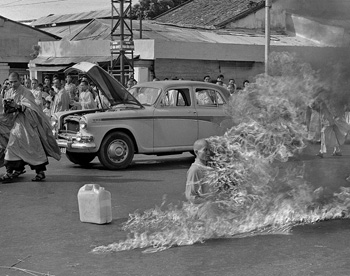
A staged self-immolation of a monk ignites the 'Buddhist crisis' and fans anti-Diem propaganda
This publicity stunt occurred while Ambassador Nolting was on vacation. He had asked to be notified should any emergencies arise, but never received any word of this crisis. Instead, he was shortly thereafter replaced as Ambassador by Henry Cabot Lodge, who disapproved of the Catholic policies of Diem.
An American-sponsored coup against Diem
Throughout this time, State Department representative Averell Harriman continued to encourage a coup against Diem. According to Nolting, who was interviewed by Dr. Shaw, three things destroyed US support for Diem:
- First, President Kennedy was sensitive to claims of the press that he was supporting a Catholic dictatorship and, thus, withdrew his support;
- Second, Averell Harriman’s group’s dislike of Diem and his family, which was fed by the news media;
- Third, the Buddhist crisis.
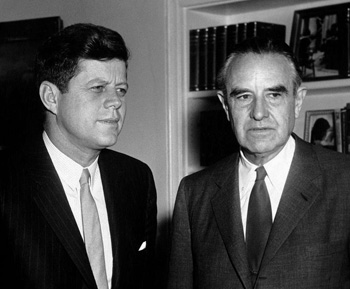
Shaw puts responsibility for Diem's assassination on Kennedy and Harriman, who pulled the strings
As amply shown by Shaw, Diem provided the only possibility for a good, stable leadership in Vietnam. Notwithstanding, the Harriman group continued to press for Diem's removal from power (assassination).
As Harriman pushed for a coup, there is no evidence that President Kennedy ever made any attempt to stop it. Kennedy ignored the advice of William Colby, Frederick Nolting, General Maxwell Taylor and Robert McNamara, as well as the counsels of several foreign governments. French ambassador Roger Lalouette, Philippine foreign secretary Salvador Lopez, the Australian government and the British Ambassador to Vietnam all urged Washington to support Diem. This coup, so relentlessly pushed by the Harriman group, was also resisted by the American Generals. A late October Congressional Fact Finding Mission to South Vietnam reported that, despite any faults of Diem, his government was winning the war against the communist insurgents.
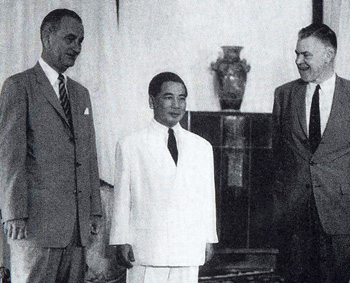
Johnson, Diem & Nolting, who always remained loyal to Diem; below, his memoirs on the betrayal
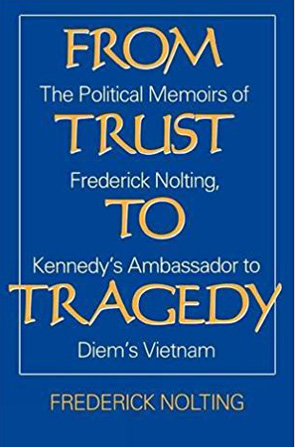
Early on November 2, the brothers were attending Mass at the local Church of St. Francis Xavier and had remained afterwards in prayer. They were outside the church standing before the grotto of the Virgin Mary when the soldiers arrived. General Duong Van Minh ordered his soldiers to murder Diem and his brother. As described by Dr. Shaw, the executioner, Major Nguyen Van Nhung, cut out their gall bladders while they were still alive and, then, shot them. (p. 267)
The grisly assassination created a political vacuum in the South Vietnamese government that could not be filled. The generals – venal, selfish men only interested in themselves – were immediately at odds and incapable of leading the country.
In 1964, Nolting resigned from the State Department in protest against the coup. In a handwritten letter to Nolting in 1971, General Harkins listed the persons and causes for the murder of President Diem and the destruction of effective US policy in Southeast Asia. He listed Harriman, Hillsman, Senator Mansfield and the press corps, in descending order. President Johnson admitted to Senator Eugene McCarthy in 1966 the truth behind the tragic 1963 coup: “We killed them. We all got together and got a G…D…bunch of thugs and we went in and assassinated him. Now we’ve really had no political stability since then.” To be fair to President Johnson, he was in favor of the Diem government and against the coup.
Unanswered questions
Several questions emerge after reading this book. Why did Kennedy authorize a coup against a fellow Catholic whom he knew personally? What was the reason for Averell Harriman's vendetta against Diem and his unflagging push for a coup despite the apparent success of Diem’s counter-insurgency program and the lack of any good replacement for Diem? Clearly, his elimination would only result in a political vacuum and chaos.
The good and the evil
The basic theme of this book is a struggle between good and evil, or of counter-revolution vs. revolution. The good is represented by Ngo Dinh Diem and his brothers, Nhu and Thuc. The latter was Bishop of Hue and was in Rome attending the second session of Vatican Council when the coup overthrew and assassinated his younger brother Ngo Dinh Diem. Bishop Thuc left the Council in protest of its progressivist documents and later was involved with Traditionalist Catholic movements.
Other characters for the good were Frederick Nolting, a loyal supporter of Diem, William Colby, who later became head of the CIA and Sir Robert Thompson.
The evil side was represented by Averell Harriman of the U.S. State Department, the young reporters Halberstam and Sheehan, eager to make a name for themselves by spreading sensationalist news, the communists, some activist Buddhists and John F. Kennedy, who, influenced by Harriman, threw Diem to the wolves to gain re-election.
At his martyrdom, Gabriel Garcia Moreno shouted “Dios no muere” [God does not die] in response to his assassin’s statement that “el tirano muere” [the tyrant dies]. The last words of Diem are unknown, but we know that this valiant Catholic died before the grotto of the Virgin in prayer.
The coup took place on All Soul’s day in 1963 and he was murdered the next day. President John F. Kennedy, ironically, was assassinated three weeks later, perhaps as a “reward” for his betrayal of Ngo Dinh Diem…
Some interesting facts about Averell Harriman
The story of Averell Harriman is not really addressed by Dr. Shaw in any detail. What were Harriman’s reasons to attack Ngo Dinh Diem and to push for his "removal" e.g. assassination? In a book by Anthony C. Sutton titled America’s Secret Establishment, An Introduction to the Order of Skull and Bones, one finds informative facts that help answer those questions.

Churchill, Harriman & Stalin meeting in Moscow; Harriman always supported communist interests
Harriman and his brother established the W.A. Harriman Company, which merged with Brown brothers in 1933 to become Brown Brothers Harriman. Notable employees included George Herbert Walker and his son-in-law Prescott Bush, grandfather of the future President Bush. Averell was on the board of Brown Brothers Harriman, as well as Guaranty Trust Company. In 1925 a concession agreement was made with Harriman Company and Guaranty Trust to develop manganese deposits in the USSR by making a $4 million loan to the Soviets. (p. 151) This was illegal at the time according to US law.
In 1941, Harriman was placed in charge of the lend-lease program to Great Britain and Russia, which assured the flow of US technology and products to the Soviet Union. (p. 163) Treasury currency plates were also shipped to Russia so that the Soviets could freely print U.S. dollars. Also in 1941, Harriman was made Ambassador to the Soviet Union.
In another work, The Unseen Hand by A. Ralph Epperson, we read that Lenin gave three oil boring concessions to three major oil companies: Standard Oil, The Comparre Oil Company of New Jersey formed by W. Averell Harriman, and Royal Dutch Shell. (p. 327) The same book demonstrates how Lenin rewarded those who helped him finance the Russian Revolution by inviting them to become part of the International Bank he was creating. (p. 111) These banks were said to be Chase National Bank, Equitable Trust, Guaranty Trust and Kuhn-Loeb.
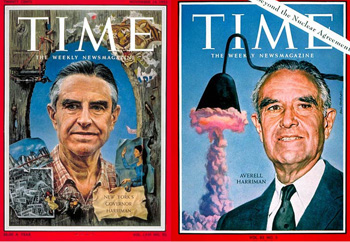
Harriman on the covers of Time magazine
In Wikipedia, it states that in December, 1961 "Anatoly Golitzyn defected from the Soviet Union and accused Harriman of being a Soviet spy, but his claims were dismissed by the CIA.” It further affirms that not only did Harriman support the coup against South Vietnamese President Ngo Dinh Diem in 1963, but "the orders that ended in the death of Diem and his brother actually originated with Harriman and were carried out by Henry Cabot Lodge’s military assistant.”
He also advocated for the neutral government in Laos that led to the removal of anti-communist forces from Laos while, because of the lack of supervision, the communists remained. This permitted the development of the Ho Chi Minh Trail that was instrumental in the defeat of South Vietnam.
Thus, it can be said that Harriman had a long history of supporting the communists, which would explain his zeal to be rid of Diem.
When he graduated from Yale in 1913, Harriman inherited the largest fortune in America, according to Wikipedia. It should also be noted that Harriman did business with the Nazis as well as the Soviets in World War II. Finally, in addition to being a member of Skull and Bones, Harriman was a member of the Council of Foreign Relations.

Posted August 28, 2017
______________________
______________________
 Volume I |
 Volume II |
 Volume III |
 Volume IV |
 Volume V |
 Volume VI |
 Volume VII |
 Volume VIII |
 Volume IX |
 Volume X |
 Volume XI |
 Special Edition |


